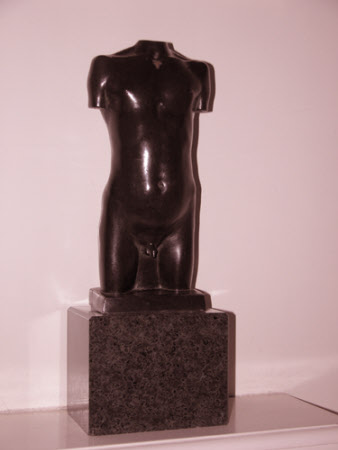Male torso
James Woodford (Nottingham 1893 - Nottingham 1976)
Category
Art / Sculpture
Date
c. 1925 - 1945
Materials
Bronze
Measurements
318 x 153 x 104 mm
Place of origin
London
Order this imageCollection
Anglesey Abbey, Cambridgeshire
NT 515016
Summary
Bronze, male torso, James Woodford (1893-1976), c. 1925-45. A bronze sculpture of a male torso, without head, arms or legs, by the British sculptor James Woodford (1893-1976). The torso wears at its neck a small gilt cross on a necklace decorated with a Greek key pattern. Mounted on a verde antico marble plinth.
Full description
This sophisticated small bronze torso of a young male is distinguished by the addition around the neck of a collar from which is suspended a small gilded crucifix. On the underside of the green marble plinth is a printed label for the art packers and transporters Bourlet. Although the label is damaged, part of the artist’s name and address survive, sufficient to allow the sculptor to be identified as James Woodford, who between 1930 and c. 1948 lived at 5, Adelaide Road, London NW3; he is for example recorded at this address in 1939 (R.B.S. Modern British Sculpture, London 1939, p. 112). Born in Nottingham, after early studies at the Nottingham School of art followed by service in the First World War, James Woodford studied at the Royal College of Art and the British School at Rome. He built a successful career working in a range of media and forms, but specialising in architectural and heraldic sculpture, for example the enormous bronze doors for the Royal Institute of British Architects on Portland Place, London (1932-34), bronze doors and bases of two flagposts for Norwich City Hall (1938), or the Second World War memorial fountain and statues in the central courtyard of British Medical Association House, Tavistock Square (c.1951-54). Woodford’s best known work was a series of ten large heraldic statues, The Queen's Beasts, depicting the genealogy of Queen Elizabeth II, commissioned for the 1953 Coronation. Woodford exhibited regularly at the Royal Academy summer exhibitions between 1926 and 1970, and at exhibitions elsewhere throughout the UK. These exhibitions included the Aberdeen Artists' Society Exhibition of Works of Modern Artists in 1931, at which Woodford exhibited a Torso of a Young Boy, in an unspecified medium. In 1927, at the Royal Academy Summer Exhibition, he showed two works in bronze, an ‘Italian Madonna’ (no. 1488’ and ‘Jacopo, torso, bronze’ (no. 1542). His few surviving works of this type demonstrate Woodford’s skill as a draughtsman and sculptor of anatomy. The small bronze torso, which appears to depict a young probably still adolescent male, is especially close to a fine pencil drawing of a male nude dating from the mid-1920s, formerly with the dealers Liss Llewellyn, who had acquired it with other works from the artist’s son. Jeremy Warren 2019
Provenance
Bequeathed to the National Trust by Huttleston Rogers Broughton, 1st Lord Fairhaven (1896-1966) with the house and the rest of the contents.
Credit line
Anglesey Abbey, The Fairhaven Collection (The National Trust)
Marks and inscriptions
On underside of base: ‘TORSO OF BOY BRONZE’, most of remainder of written text lost, but part of artist’s name ‘[…FORD Ja…’. and part of address :[… elaide / …3] survive.
Makers and roles
James Woodford (Nottingham 1893 - Nottingham 1976), sculptor
References
Christie, Manson & Woods 1971: The National Trust, Anglesey Abbey, Cambridge. Inventory: Furniture, Textiles, Porcelain, Bronzes, Sculpture and Garden Ornaments’, 1971, p. 150.
